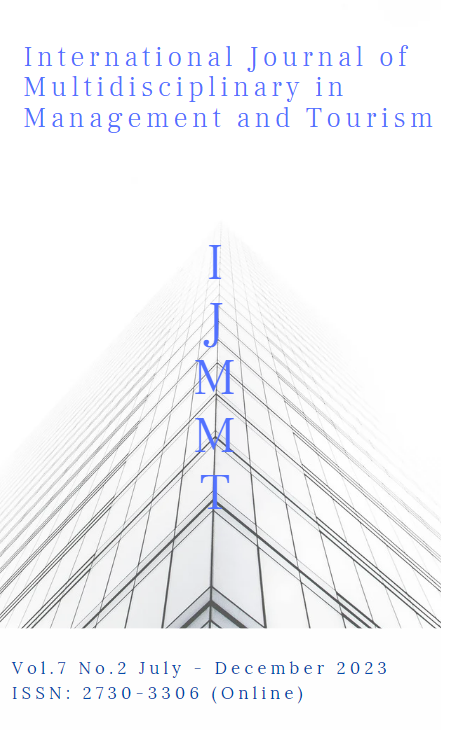The Impact of Business Model Innovation on the Performance of Small and Medium-Sized Internet Enterprises in Nanchang City, Jiangxi Province, China
Main Article Content
Abstract
This article aimed (1) To study the factors that affect business model innovation and corporate performance. (2) To study the methods to improve the operational performance of the enterprise and (3) To create a business model innovation development model. The sample for the quantitative research method was 300 of small and medium-sized Internet enterprises in Nanchang City, Jiangxi Province, and conducts a questionnaire survey. They were selected by the Krejcie & Morgan method (1970) with a sample size error of 5% or 0.05. The qualitative research method is in-depth interview. The main subjects are senior managers of small and medium-sized Internet companies, professors engaged in management research in colleges and universities, and experts working in the government for enterprises. A total of 8 people conducted face-to-face interviews. Analysis data by Descriptive statistics and Content Analysis. The research results were found as follows;
- Regarding the influencing factors of business model innovation and corporate performance, the research finds that we can use capability innovation management and management skills as intermediate variables for research. Enterprises can promote enterprise performance by creating and developing a variety of new marketing channels, creativity and business process reengineering, the ability to create additional value for products, and improving technical skills, interpersonal skills and conceptual skills.
- In the original conceptual framework, we have a total of 5 assumptions. With the help of the SEM model, the final conclusion is that assumption 2 does not hold. So, the new model can remove assumption 2 and keep other assumptions.
- With regard to the innovative development model of enterprises, it is necessary to focus on choosing an efficient business model or a novel business model from the perspective of changes in income model, operation model, technology model, and industrial model.
Article Details

This work is licensed under a Creative Commons Attribution-NonCommercial-NoDerivatives 4.0 International License.
References
Afuah, A. (2003). Business Models: A strategic management approach. McGraw-Hill Press.
Afuah, A., &Tucci, C (2001). Internet business models and strategies: Text and cases. McGraw-Hill/Irwin.
Amit, R., & Zott, C. (2001). Value creation in E-business. Strategic Management Journal, 226-7), 493-520. https://doi.org/10.1002/smj.187
Bernardin, H. J., Hennessey, H. W., & Peyrefitte, J. (1995). Age, racial, and gender bias as a function criterion specificity: A test of expert testimony. Human Resource Management Review, 5(1), 63–77. https://doi.org/10.1016/1053-4822(95)90008-X
Boonyapraropchai, N., & Premthongsuk, P. (2023). A causal relationship model of factors affecting happiness at work of department stores employees in Bangkok. Journal of Educational Management and Research Innovation, 5(1), 147–162.
Chen, T. B. (2017). An analysis of the conceptual skills of entrepreneurs. Labor Protection World.
Chesbrough, H.(2005). Open innovation: the new imperative for creating and profiting from technology. Tsinghua University Press.
Chesbrough, H., Rosenbloom, R. S.(2002). The role of the business model in capturing value from innovation: Evidence from xerox corporation's technology spin-off companies. Industrial and Corporate Change,11(3), 529-555. https://doi.org/10.1093/icc/11.3.529
Drucker, P. F. (1973). The Performance Gap in Management Science: Reasons and Remedies. Organizational Dynamics, 2(2), 19-29.
Dubosson Torbay, M, Osterwalder, A., & Pigneur, Y.(2002). E-business model design, classification and measurements. Thunderbird International Business Review, 44(1), 5-23. https://doi.org/10.1002/tie.1036
Gabin, Y., & Di, X. (2018). The mechanism of big data's influence on business model innovation-an analytical framework. Science and Technology Progress and Countermeasures, 35(03), 15-21.
Gordijn, J., Akkermans, J., & van Vliet, J. (2001). Designing and evaluating e-business models. IEEE Intelligent Systems, 16(4), 11 -17. https://doi.org/10.1109/5254.941353
Hammer, M., & Champy, J. (1993). Reengineering the corporation: A manifesto for business revolution. Harper Business.
He, C., & Sun, P. (2023). Behavioral effects of performance in distinguishing between work connectivity behavior after-hours: Recognition role to compensation payments of workers fairly. Journal of Multidisciplinary in Humanities and Social Sciences, 6(1), 289–307.
Kanchanda, K. (2021). The Causal Model of Knowledge Management, Business Model Innovation, and Competitive Advantage of Entrepreneurs in Small and Medium Enterprises. Journal of Nakhon Ratchasima College (Humanities and Social Sciences). 15(2), 210-223.
Kaplan, R. S., Norton, D. P. (1992). The balanced scorecard-measures that drive performance. Harvard Business Review, 70 (1), 71-79.
Karin, K., Walalite, T., Utiram, K., Kaewkla, K., & Apisupakronkun, P. (2023). Factors Influencing Supplementary Jobs During the Covid-19 Situation. Journal of Educational Management and Research Innovation, 5(1), 25–36.
Katz, R. L. (2009). Skills of an Effective Administrator. Harvard Business Review Press.
Kun, Z. (2019). Study on the mechanism of learning orientation on the performance of start-up companies. Jilin University.
Linjee, C., Rattanavisut, S., Sutthitham, N., & Sangsuk, S. (2023). Efficiency of accounting information system used for enterprise resources planning of small and medium enterprises in Bangkok. Journal of Multidisciplinary in Humanities and Social Sciences, 6(2), 851–864.
Mencarelli, R., Rivière, A., & Lombart, C. (2021). Do myriad e-channels always create value for customers? A dynamic analysis of the perceived value of a digital information product during the usage phase. Journal of Retailing and Consumer Services, 63, 102674. https://doi.org/10.1016/j.jretconser.2021.102674
Onraksa, K., & Lekhavat, S. (2023). Implementing the economic ordering quantity principle for supplier selection: A case study of building store. Journal of Educational Management and Research Innovation, 5(2), 305–314.
Qin, T. (2000). Practice and reflection of conceptual skills in grassroots bank management. International Finance, 7, 51-54.
Yoosuk, S., Shoommuangpak, P., & Pornpundejwittaya, P. (2023). The effect of accountant professional skills on performance in the new normal era. Journal of Multidisciplinary in Humanities and Social Sciences, 6(1), 379–393.
Zhenshan, B. et al. (2022). Retail business model innovation in the era of digital economy: motivation, method and path. China Circulation Economy, 36(7), 12-21.
Zott, C., & Amit, R. (2017). Business model innovation: How to create value in a digital world. NIM Marketing Intelligence Review, 9(1), 18 – 23. https://doi.org/10.1515/ gfkmir-2017-0003
Zott, C., Amit R. (2008). The fit between product market strategy and business model: Implications for firm performance. Strategic Management Journal, 29(1), 1-26.
Zott, C., Amit, R. (2007). Business model design and the performance of entrepreneurial firms. Organization Science, 18(2), 181-199.

